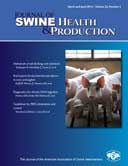Abstract:

General guidelines for porcine reproductive and respiratory syndrome regional control and elimination projects
Enrique Mondaca, DMV, PhD; Laura Batista, DVM, PhD; Jean-Paul Cano, DVM, PhD; Edgar Díaz, DVM, MSc; Reid Philips, DVM; Dale Polson, DVM, PhD
Complete article is available online.
PDF version is available online.
Porcine reproductive and respiratory syndrome (PRRS) continues to be a costly disease affecting the swine industry worldwide. While veterinarians have developed a variety of strategies to control and eliminate the disease from pig herds, the risk of re-infection remains high even with the best current practices of management and biosecurity. The repeated failures of non-coordinated control and elimination efforts and the ease with which the disease is transmitted from one herd to another strongly suggest that a regional approach will be necessary. The regional approach for fighting PRRS proposes control in areas of high PRRS prevalence and high pig density, while elimination is potentially feasible in areas of low PRRS prevalence and low pig density. The purpose of this document is to outline a plan to implement PRRS regional control and elimination projects. The plan consists of five phases: evaluate the feasibility of the project, identify pig-related facilities in the area, classify pig sites according to their PRRS virus infection status, design PRRS control strategies, and execute and monitor these PRRS control strategies. Eventually, the focus of individual projects will be to merge with adjacent regional projects and, depending on overall infection risk and feasibility, pursue PRRS elimination.
Keywords: porcine reproductive and respiratory syndrome, PRRS, control, elimination, regional
![]() Cite as: Mondaca E, Batista L, Cano JP, et al. General guidelines for porcine reproductive and respiratory syndrome regional control and elimination projects. J Swine Health Prod 2014;22(2):84-88.
Cite as: Mondaca E, Batista L, Cano JP, et al. General guidelines for porcine reproductive and respiratory syndrome regional control and elimination projects. J Swine Health Prod 2014;22(2):84-88.
Search the AASV web site for pages with similar keywords.
